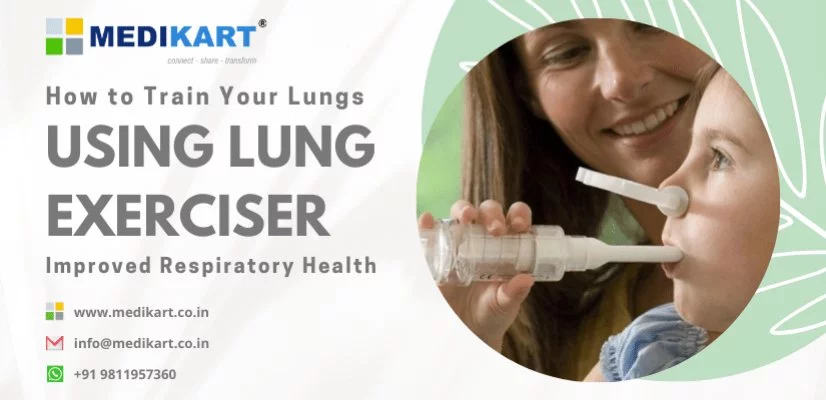Maintaining good respiratory health is crucial for overall well-being, and training your lungs can play a vital role in achieving that. Whether you’re an athlete looking to boost endurance or someone seeking to enhance lung function, incorporating lung exercises into your routine can have significant benefits. One effective method of training your lungs is by using a lung exerciser. In this blog, we will explore the importance of respiratory health, common symptoms of respiratory issues, and provide you with exercises and devices that can help improve your lung capacity and overall respiratory health.
The Significance of Respiratory Health:
Our lungs are responsible for supplying oxygen to the body and expelling carbon dioxide. However, various factors such as sedentary lifestyles, pollution, smoking, and respiratory illnesses can impact lung function. By actively training our lungs, we can enhance their capacity, increase oxygen intake, and strengthen the respiratory muscles, leading to improved overall health and well-being.
Common Symptoms of Respiratory Issues:
Recognizing the signs of respiratory issues is crucial in identifying potential problems and taking proactive measures. Some common symptoms that may indicate respiratory concerns include:
- Shortness of Breath: Feeling breathless during physical exertion or even at rest.
- Chronic Cough: A persistent cough that lasts for several weeks, often accompanied by phlegm production.
- Wheezing: A high-pitched whistling sound during breathing, typically caused by narrowed airways.
- Chest Tightness: A sensation of pressure or discomfort in the chest area.
- Fatigue: Feeling tired or lacking energy due to inefficient oxygen intake.
- Recurrent Respiratory Infections: Frequent colds, flu, or respiratory infections.
Exercises to Improve Lung Capacity:
To train your lungs and improve respiratory health, here are some effective exercises you can incorporate into your routine:
- Deep Breathing: Sit or lie down comfortably, inhale deeply through your nose, and feel your abdomen rise. Exhale slowly through your mouth, pushing out as much air as possible. Repeat this exercise for several minutes each day to expand your lung capacity.
- Pursed Lip Breathing: Inhale slowly through your nose, then exhale gently through pursed lips, as if you were blowing out a candle. This exercise helps regulate breathing and improves lung function.
- Diaphragmatic Breathing: Lie on your back with your knees bent or sit comfortably. Place one hand on your chest and the other on your abdomen. Inhale deeply through your nose, allowing your abdomen to rise while keeping your chest relatively still. Exhale slowly through your mouth, emptying your lungs completely. This exercise helps engage the diaphragm and strengthens the respiratory muscles.
Lung Exercisers for Improved Respiratory Health:
In addition to exercises, various lung exercisers or respiratory training devices can assist in strengthening your lungs and improving respiratory health. Here are some commonly used devices:
- Spirometers: Spirometers are handheld devices that measure lung capacity and airflow. They provide visual feedback, allowing you to track your progress over time.
- Inspiratory Muscle Trainers (IMTs): IMTs focus on strengthening the muscles used during inhalation. They consist of a device with adjustable resistance levels. By inhaling against the resistance, you can gradually increase lung capacity.
- Positive Expiratory Pressure (PEP) Devices: PEP devices help with mucus clearance and airway hygiene. They generate resistance during exhalation, helping to open up the airways and improve lung function.
- Oscillatory Positive Expiratory Pressure (OPEP) Devices: OPEP devices combine PEP therapy with oscillations that help break up mucus and improve airway clearance. These devices provide resistance during exhalation, creating vibrations that help loosen mucus and improve lung function.
Using a lung exerciser:
When using a lung exerciser, it’s important to follow these guidelines:
- Consult a healthcare professional: If you have pre-existing respiratory conditions or concerns, it is advisable to consult a healthcare professional before starting any lung training regimen. They can provide personalized guidance and recommend specific exercises or devices suitable for your needs.
- Choose the right device: Select a lung exerciser that suits your goals and needs. Consider factors such as resistance levels, ease of use, and portability. Read the instructions provided by the manufacturer carefully to understand the proper usage.
- Start slowly and progress gradually: Begin with lower resistance levels and gradually increase as your lung capacity improves. Pushing yourself too hard initially can cause strain and discomfort. Listen to your body and increase intensity at a comfortable pace.
- Consistency is key: Incorporate lung exercises into your daily routine for optimal results. Aim for regular sessions of 10-15 minutes, gradually increasing the duration as you progress. Consistency is important to train and strengthen your lungs effectively.
- Monitor your progress: Keep track of your lung capacity and any improvements you notice over time. Some devices, such as spirometers, provide visual feedback, allowing you to track your lung function. Alternatively, you can maintain a journal to record your exercises, perceived improvements, and any symptoms you experience.
Conclusion:
Training your lungs through exercises and using lung exercisers can significantly improve respiratory health, increase lung capacity, and strengthen respiratory muscles. By recognizing common symptoms of respiratory issues and taking proactive measures, you can stay vigilant about your lung health.
Incorporate exercises like deep breathing, pursed lip breathing, and diaphragmatic breathing into your daily routine to enhance lung capacity and strengthen respiratory muscles. Additionally, consider utilizing lung exercisers such as spirometers, inspiratory muscle trainers, PEP devices, or OPEP devices to further improve your lung function.
Remember to consult a healthcare professional, especially if you have pre-existing respiratory conditions, for personalized guidance and recommendations. With consistency, patience, and the right techniques, you can train your lungs and enjoy improved respiratory health for a better quality of life. Breathe deep, stay healthy, and embrace the benefits of well-trained lungs.
Disclaimer
The information provided is for general knowledge only. Consult your doctor for personalized advice and treatment. Medikart HealthCare is not liable for any actions taken based on this info.

